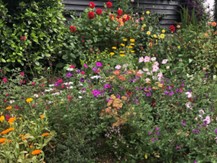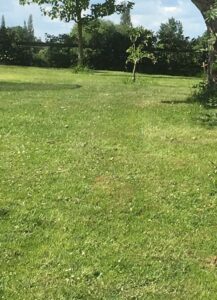
The world today can be a stressful place for all generations. Even amongst our younger generation, I am constantly hearing the words stress and anxiety used. With the huge leaps we have made in technology, the prevalence of screens and social media, it would seem that many of us are living a more secluded and indoor lifestyle. As humans our natural habitat is to be outside and with others so it follows that we are finding it hard to cope with this new way of life and many of us are becoming screen dependent, stressed and tired.
Many studies have been undertaken in recent years to find out if there is a link between spending time outdoors in nature and a reduction in stress. One study, undertaken by Frontiers in Psychology, found that spending just 20 minutes connecting with nature can help lower stress hormone levels. Another study, by college students, found that only 10 minutes a day outside was needed to lower stress levels and one by Science Direct found improvements to mental health as a result of outdoor time. According to their research, nature excursions can help alleviate feelings of time pressure and mental stress. Taking a break from urban settings and spending time outdoors in the wilderness increased life satisfaction, happiness and mindfulness in study participants.
The message is clear, we need to take a break from our screens and spend some time outside in green and growing surroundings. This doesn’t need to cost a lot of money or take up too much time as this will only add to your stress. The idea here is to build in stress-free outdoor time amongst nature to your daily routine so it is easy, enjoyable and beneficial.
Here are some low-cost, close-to-home and environmentally friendly ways to spend 10 minutes or more a day outside.
Whether you work at home or in a public building/office, eat your lunch outside. It’s all too tempting to eat and work at your desk, but allow yourself time away from your screen to eat and you’ll probably find you’re far more productive. When I was younger I worked as an office temp one summer in the historic town of Bury-St-Edmunds. Every day at lunchtime I would take my homemade sandwiches to the beautifully maintained Victorian Abbey Gardens and sit on one of the many park benches to eat them. The flowers looked glorious and the birds and squirrels enjoyed roaming around in them. Not only was this free it was a great way to unwind after a morning staring at a computer screen and gave a refreshing break from the artificially lit office. I’m sure spending time in the natural sunlight certainly reduced any stress that I had.
If you are lucky enough to have a garden then add some new plants to it and spend 10 minutes a day watering and looking after them. If you are short of space, plant a few containers or window boxes, you’d be surprised what you can fit into the smallest of spaces. This will instantly make your garden, patio, balcony or window box look beautiful and will mean you want to spend time there de-stressing, it will also increase the amount of visiting pollinating insects that visit which will be beneficial for the environment.
Alternatively, there are voluntary groups popping up in different towns across the country. An example of this is Abundance London in Chiswick, London.

Abundance London find neglected lost public spaces and plant them up with greenery and flowers. If you have time to volunteer you could help a group like this, creating or nominating a space near you and seeing if there is a group locally who would be happy to plant it up for the benefit of all of the local community. According to the founder of Abundance London Karen Liebreich, these new green spaces welcome people and wildlife and become “little pockets of beauty and biodiversity for insect life and people”. You may also encourage more people to get outside and de-stress by creating beautiful areas to spend time in.
Mowing a lawn each week would provide you with exercise and outside time. If you don’t have your own lawned area but have enough space, you could find an area of your garden in which to create one. Or, if that isn’t an option, why not volunteer to help someone who struggles to mow their lawn? Either way, a lawn is a great benefit to nature.
Among the many benefits of natural lawns, every 250m2 healthy lawn will absorb CO2 and produce enough oxygen to sustain a family of four. Mowing the lawn is also good for other senses. It has been found that the smell of freshly cut grass regularly tops the list of best smells in the world so it follows that inhaling the scent as you mow could make you feel comforted and relaxed. Again, another way to get outside and de-stress.
If you commute to work in the car or drop the children off on a school run why not try and change where you park your car e.g. at a park and ride and walk from there. For those who take public transport why not get off a stop early and walk the last few steps amongst tree lined streets and gardens? You might find not only do you save money by travelling less miles in a vehicle or avoiding parking charges but by walking to work and spending time in nature you reduce your stress levels as you soak up the sights and smells of nature, not to mention getting fitter at the same time.

If you drive your children to school but it’s close enough to walk, why not leave the car at home and go on foot instead. You could save yourself a small fortune in petrol and it would also be better for the environment having fewer fumes pumped into the air. When you’re working from home, try taking a 20 minute break away from your desk have a walk round your garden. Take off your shoes when you are walking on grass because standing barefoot on natural grass is proven to trigger a reduction in the signs of stress, with lowering of both heart rate and blood pressure. Look for blossom on trees, flowering shrubs and flowers that are in bloom so that your sense of smell is engaged as you walk past and your stress is reduced further. If you don’t have a garden try to visit the nearest place to you with grass, plants and trees such as a park or local footpath. There are many websites and apps that can help you discover green places that you can walk to in your local area – www.gps-routes.co.uk is a good place to start.
According to Forest England, Forest Bathing is “This Japanese practice is a process of relaxation; known in Japan as shinrin yoku. The simple method of being calm and quiet amongst the trees, observing nature around you whilst breathing deeply can help both adults and children de-stress and boost health and wellbeing in a natural way.” If you’re lucky enough to have a forest nearby then taking a daily walk there is a great way to spend your time destressing and won’t cost a penny. Many suburban streets are filled with large leafy trees so if you live near one of these streets why not take a stroll there. Alternatively, find a park or a large tree near you and spend time sitting underneath it soaking up the atmosphere. The Forest England website (https://www.forestryengland.uk/blog/forest-bathing ) have some great tips on how to get the most out of Forest Bathing and includes a list of forests that you can visit plus a free downloadable family pack of ways you can begin forest bathing at home.
NHS doctors have been using ‘green prescriptions’ for some years. In July 2020, Environment Secretary at the time George Eustice announced a £4 million investment for a cross-government project aimed at preventing and tackling mental ill-health through green social prescribing. Initial evidence shows that doctors who use green social prescribing (prescribing gardening activities instead of medicine) found that there were 28% fewer GP consultations and 24% fewer A&E attendances for people receiving social prescribing support. Green social prescribing involves the GP prescribing the patient with gardening and linking them with a local community group. If this sounds appealing to you why not look into organising your own voluntary work within the local community. Schools, adult learning groups, care homes, stately homes, places of worship and community gardens are just some of the places that you could volunteer and spend some time outside. The benefits of volunteering this way are huge: you could learn new skills, spend time with other people and make new friends while improving the outdoor environment for others which can bring an enormous sense of well being and happiness.
Following just one of these tips will hopefully help you to spend 10 minutes of your day outside in nature, lowering your stress levels, saving money, making new friends and reducing your carbon footprint which is great for the environment. Very importantly, remember that when you are taking your stress-free time outside put away your screen so that you can fully connect with nature and feel its true benefits. So what are you waiting for? Find a gorgeous green patch of grass, take off those socks and shoes and enjoy the feel of it between your toes!
Guest Author: Nicky Sharp
Nicky is a green-fingered mum of three who until recently was a self-taught gardener. Having left her teaching career to support her young family, she has now been able to pursue her passion for horticulture, recently embarking on an RHS course to enhance her expertise.